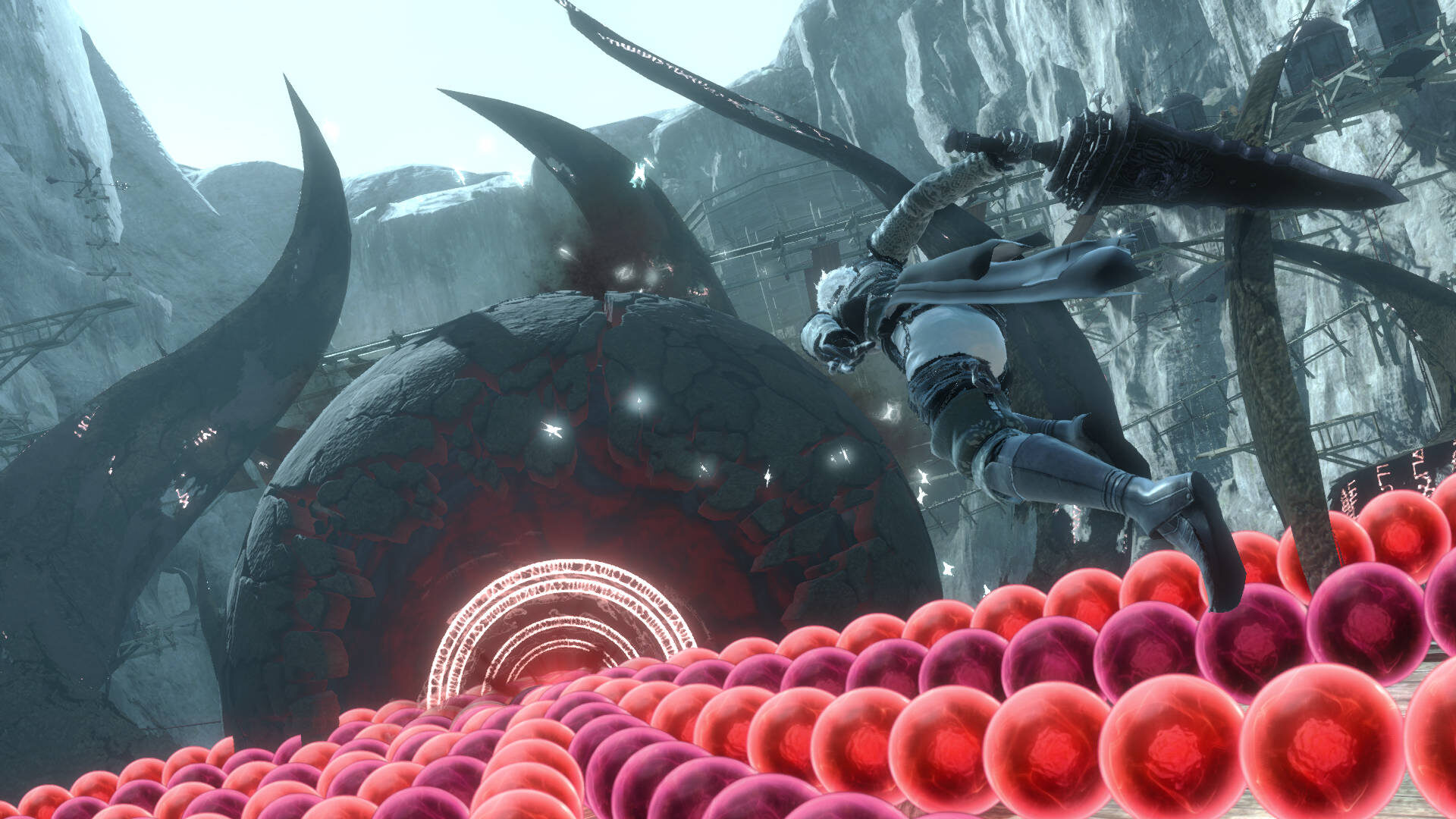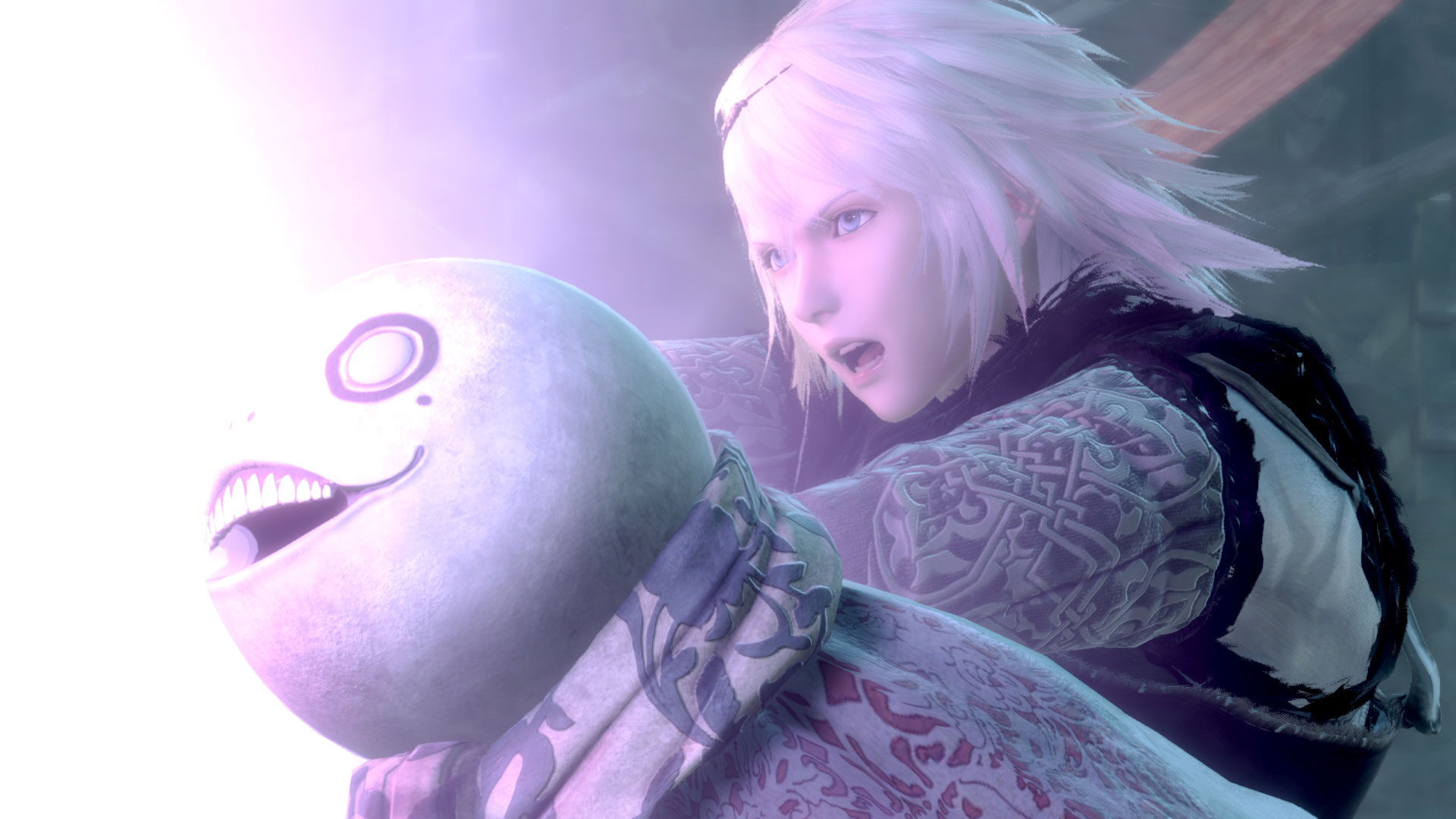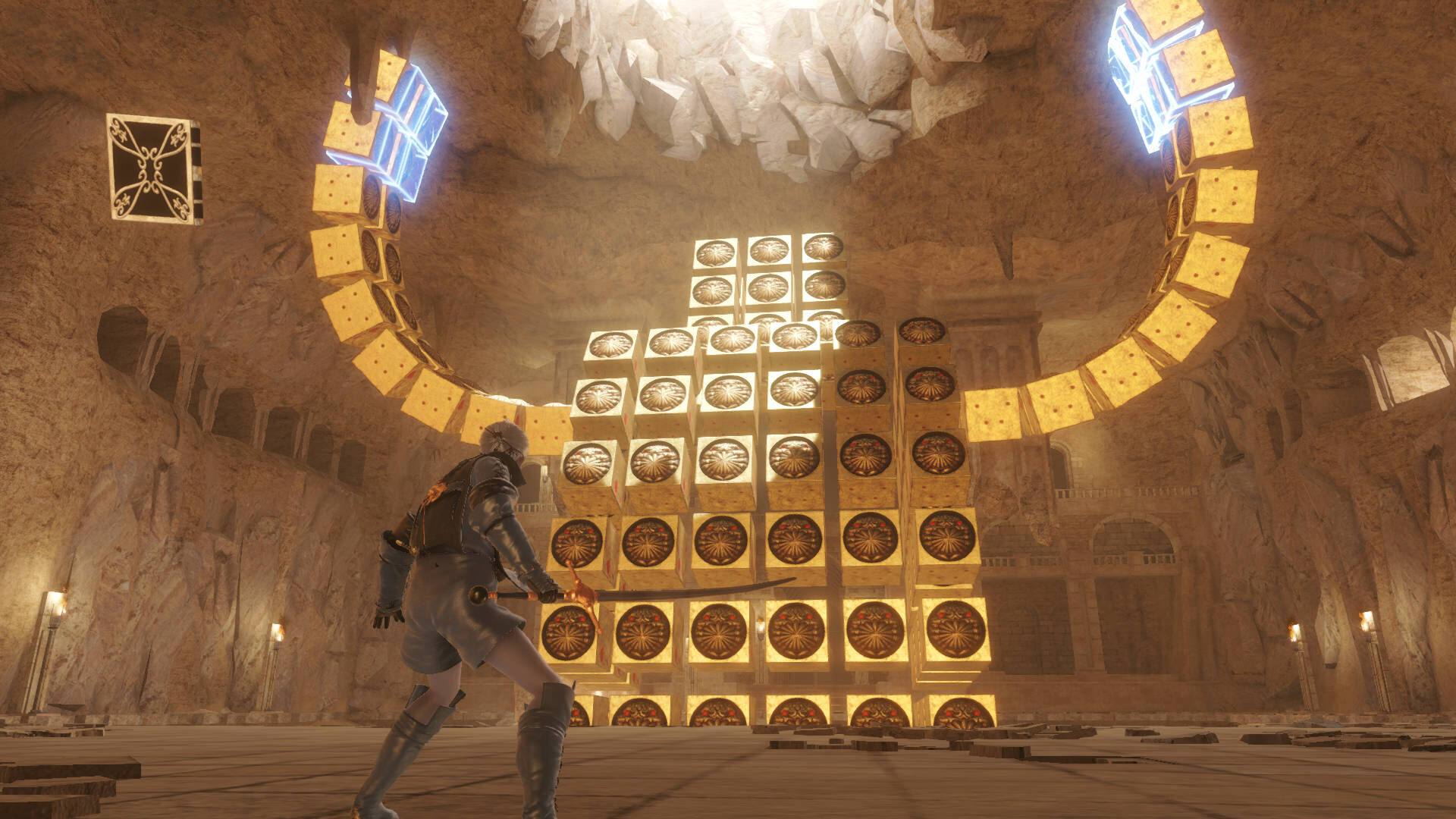For days, I was certain I’d open this review by saying that NieR was one of the games that I’m ashamed to have missed the first time around, and that it shouldn’t have taken me 11 years to finally, properly play it.
The thing is, in sitting down with the remake of Yoko Taro’s cult classic, I came to actually appreciate why I’d given up on it the first time around. Like the original PlayStation 3 and Xbox 360 release it refreshes for a new era, NieR Replicant ver.1.22474487129… (henceforth NieR Replicant) starts off incredibly pedestrian. Put aside any knowledge you have of any of Taro’s other games, style of storytelling, or simply his personality, and it can feel like a generic, low-budget, by-the-numbers Japanese action RPG.

Much like its sequel NieR Automata, NieR Replicant takes a couple of hours to really kick into gear—but once it does, oh boy. I’ve come to dislike the “just give it X amount of time and it’ll get good, honest” argument, but it legitimately is true here. The game does have signs of the depth and weirdness that are to come, but they’re small at first, and easy to miss unless you already know to be looking for them.
Everything kicks off with a teenage boy—technically named Nier, but his in-game name is up to you as the player—and his younger sister Yonah. Yonah’s physical health is deteriorating due to an illness called the Black Scrawl, and Nier is desperate to find a cure. A potential solution finally arises after a fateful meeting with a floating, talking book named Grimoire Weiss. It seems that Weiss is not only destined to put an end to the Black Scrawl, but also the monsters called Shades that have been invading the land in increasing numbers.
Nier and Weiss set off on an adventure across the land searching for the Sacred Verses, a collection of pages that will hopefully give the pair the power they need to defeat the Shades, put an end to the Black Scrawl, and save Yonah. In gameplay terms, the Sacred Verses are a series of new abilities that unlock for Weiss, letting him fire off magical lances, conjure up a protective wall, or unleash other offensive and defensive capabilities. (While Weiss is not directly controllable, he follows you around wherever you go, and you fire off his abilities using the shoulder buttons.) These combine with Nier’s control over human weaponry, starting with a selection of swords before moving on to other melee options. While Nier’s attack power is mostly dependent on which weapon he has equipped, you can modify each weapon with “words” you’ve collected throughout the world. For example, I modified the name of my favorite one-handed sword with words that boosted its attack power and the XP I gained from using it, while I customized my go-to spear to better break enemy armor and reduce the MP cost of Weiss’ spells.

Though I cannot speak as an expert on all of the changes we’ve gotten going from the original NieR to NieR Replicant, I can say that probably the biggest upgrade comes when fighting enemies. NieR’s combat was serviceable, but after PlatinumGames infused its trademark blend of “stylish action” into NieR Automata, “serviceable” wouldn’t have cut it for all of those coming to Replicant as new players. While the game is no Automata—and Nier certainly no 2B—I enjoyed the action here way more than I had expected to. Juggling Nier’s skills as a swordsman, Weiss’ various abilities, the different weapon selections, parries, and the other elements of the combat system is a lot of fun, and keeps fights with the game’s enemies fresh the entire way through. I did at times long for Automata’s mid-combo weapon switching, but I have no hesitation in saying that Replicant is never relegated to simply existing in its sibling’s shadow.
Another area in which NieR Replicant improves on its predecessor is in the way of visuals and performance—and this may or may not be a source of disappointment for some. I want to be clear that I’ve got no personal complaints with the graphics in Replicant. I think the game looks good, the upgraded character models are great, and performance was totally solid for me other than two, maybe three, times where the framerate seemed to hitch momentarily due to very specific battle situations.
That being said, some people put a lot of expectations on what a “remake” should be. This is nowhere near the level of a Final Fantasy VII Remake or Demon’s Souls, but it also isn’t always as impressive as other less-ambitious projects in terms of world complexity, object geometry, or textures. Replicant reminds me a lot of Automata in those areas, and for me, that’s perfectly fine. If you were one of the people who thought Automata looked “cheap,” then you’re probably going to have the same complaint here. I would like to see the game get a next-gen upgrade though, as even when running on the PlayStation 5, load times can still run longer than I expected.
While this is an area I have trouble commenting directly on, it’s impossible to review NieR Replicant without mentioning its soundtrack. Much like its younger sibling NieR Automata, the music here is heavenly, composed by the incredibly talented Keiichi Okabe. However, my understanding is that the remake’s soundtrack has also gotten some upgrades, and I’ve seen comments from a few fans who prefer the original mixes of the songs where they’ve been able to directly compare between the two releases. So, while newcomers won’t know the difference, longtime fans definitely might.
There’s one other major aspect NieR Replicant offers over the original NieR, and it ties in to what is unquestionably the most important point of this—or any of Yoko Taro’s—games: story.
This gets a little complicated, but in Japan, the original NieR came out in two versions: NieR Replicant, the PlayStation 3 release which had players control Yonah’s brother, and NieR Gestalt, the Xbox 360 version which changed the main character to Yonah’s father. As the story goes, the American branch of Square Enix wanted the game to feature a more “Western-friendly” protagonist, so the team created Papa Nier (as his fans call him). And then, when the game launched outside of Japan, not only was he the main character for the Xbox 360 release, but he was also edited into the PS3 build as well.

I’m just going to be honest: Papa Nier was part of the reason I never connected with the original Nier. I know some of you out there love him, but Papa Nier was ugly—his design was dumb, his voice weird, and his personality completely unappealing as a character I’d be controlling for 20-plus hours. Finally getting to play as the originally intended main character was a big reason I got excited for NieR Replicant, and I now absolutely think he’s the way to go. Throughout the game, Nier comes to have two main allies—Kainé and Emil—and I think the growth he goes through, both on a physical and emotional level, directly reflects the growth his teammates go through as well. Maybe I’m wrong, but I just cannot imagine the story hitting as hard as it does when you put an older father figure into that slot, and I say that as someone who desperately wants more older protagonists in Japanese games.
No matter which side of the argument you fall on, one thing all fans will agree on is just how engrossing and emotional the story is. NieR Automata had taken hold of my heart by the time its (legitimate) credits rolled, and Replicant easily did the same. While I still prefer Automata’s overall world, cast, and story arc—possibly because it was simply the game I played first—I almost think that, as a whole, I may prefer Replicant’s main heroes a tad more. I’m not shocked that I liked foul-mouthed bad girl Kainé, but the big surprise was just how attached I also became to the mysterious magic-wielding boy, Emil. Along with Weiss, they make a fantastic team to have at Nier’s side while trying to save Yonah, and I especially loved how they all supported one another on a personal level. Yoko Taro is a man who knows how to craft tales about the highs and lows of humanity, leaving a game that starts off as a “generic, low-budget, by-the-numbers Japanese action RPG” as an experience that’s truly special and touching by its end—not just in terms of its narrative, but also in the depth and uniqueness of its gameplay.
There’s just one catch, and it’s a catch that I know is unfair to bring up on some level. There are going to be a lot of people who, like me, are coming to NieR Replicant off the back of NieR Automata, and from that vantage point, the former constantly feels like a prototype for the latter. Weiss comes off as an early version of the Pods, while the weapon-altering words seem like a less complex take on Plug-in Chips. Then there are the similarities in storytelling and sidequest design. The shared animal-riding aspect and gameplay gimmicks. The weapon switching. The way new perspectives unlock through multiple playthroughs. The overall world design. I could go on.

NieR Replicant feels like a less polished, less ambitious, lower-budget NieR Automata—but of course it does. Even though a lot of us are now getting to finally play it after Automata, it was originally designed and developed seven years prior for less money, using lower-level tech, and on a far less capable console. It’s not fair to expect Replicant to best Automata in most categories, but I just know at least some portion of players out there won’t understand that.
Even if we were to relegate NieR Replicant ver.1.22474487129… to “prototype” status, it’d be one heck of a prototype. This is a game that absolutely deserved to get another chance, and while I’m not sure it’ll become the sleeper hit that NieR Automata did, it’s a fascinating, captivating, and exhilarating game in its own right. If you want to finally play the first chapter of the saga, if you want to deepen your appreciation for all the little callbacks that appeared along 2B’s journey, or if you’re just looking for something different from the norm, then NieR Replicant may not be a perfect game, but it’s certainly a perfect way to spend 30-some hours—you dumbass!
|
★★★★☆
NieR Replicant ver.1.22474487129… remakes an under-appreciated action RPG for a new era of consoles and players, giving us another look into the beautifully bizarre mind of creator Yoko Taro. Replicant isn’t the most impressive remake on a technical or visual level, but it’s received some very welcome upgrades, such as an improved combat system. More importantly, the thing that didn’t need fixing wasn’t broken: the original’s captivating storyline and cast of characters. Everything in that regard is still here as it should be, just told through the eyes of the initially intended protagonist, and with a few pieces of originally cut content restored. |
Developer Toylogic Inc. Publisher Square Enix ESRB M - Mature Release Date 04.23.2021 |
| NieR Replicant ver.1.22474487129… is available on PlayStation 4, Xbox One, PC. Primary version played was for PS4. Product was provided by Square Enix for the benefit of this coverage. EGM reviews on a scale of one to five stars. | |

Mollie got her start in games media via the crazy world of gaming fanzines, and now works at EGM with the goal of covering all of the weird Japanese and niche releases that nobody else on staff cares about. She’s active in the gaming community on a personal level, and an outspoken voice on topics such as equality in gaming, consumer rights, and good UI. Check her out on Bluesky and Mastodon.